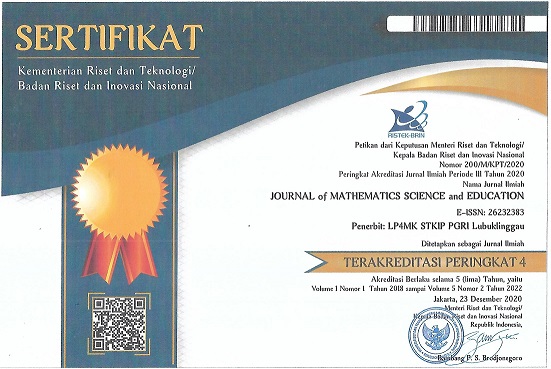PENERAPAN ALAT PERAGA PIPA LOGIKA PADA MATERI LOGIKA MATEMATIKA DI KELAS X
Abstract
The aims of this study to determine student learning outcomes in mathematical logic material after the application of logic pipe props. This research was conducted in class X.3 of SMA Muhammadiyah Pagaralam. The research method used was the experimental method with the category of one group pretest posttest design. Data collection techniques used in this study was documentation, observation, interviews, and tests. From the results of the study it can be seen that student learning outcomes in mathematical logic material using logical pipe props can be said good. This can be seen during the learning process through observation and the Student Worksheet that is done by students. In these learning activities, students in the group are active in completing the Student Worksheet and students look skilled in using the logic pipe props, so students can find out for themselves the concepts of conjunction, disjunction, implications and implications. In addition, student learning outcomes that can be seen from the post test results are classified as having a high average where the average post test score of students is 83.00. From the average score obtained by students and the activeness of students in the learning process, it can be concluded that the logical pipe props are well used in learning mathematical logic material.
References
Hidayati, K. Rohmah, U. Amalia, L. (2013). Pengaruh kemampuan penalaran logika matematika terhadap prestasi belajar mahasiswa pendidikan guru madrasah ibtidaiyah di STAIN Ponorogo. Jurnal Kodifikasi: Vol 07 no 1.
Kamsari & Winarso, W. (2018). Implikasi tingkat kecerdasan logika matematika siswa terhadap kemampuan pemecahan masalah matematika. Jurnal Pendidikan sains dan Matematika: Vol 6 no 1.
Kemdikbud.(2014). Konsep dan Implimentasi Kurikulum 2013.https://www.kemdikbud.go.id/kemdikbud/dokumen/Paparan/Paparan%20Mendikbud%20pada%20Workshop%20Pers.pdf. Diakses Pada Tanggal 20 April 2019.
Kencanawati, F.F. (2013). Kajian Learning obstacles dan Repersonalisasi Materi Logika Matematika Pada Pembelajaran Matematika SMA. Bandung: Universitas Pendidikan Indonesia, perpustakaan.upi.edu.
Muttaahidah, I. (2015). Logika Matematika, Dialekta, dan Teknik Pengambilan Kesimpulan. Jurnal AdmathEdu: Vol 5 no 2. 127 – 140.
Mirati, L. (2015). Analisis Kesulitan Siswa Belajar Matematika Pada Topik Logika pada Siswa SMK Muhammadiyah Klaten utara. Jurnal Pendidikan Matematika: Vol 2 No 1.
Novitasari, D.E. (2015). Analisis Kesalahan Dalam Mengerjakan Soal Materi Logika Matematika Mahasiswa Prodi Pendidikan IKIP PGRI Bojonegoro. Jurnal Pendidikan dan Pembelajaran Matematika (JP2M): Vol 01 no 1.
Suwanti,V. (2016). Penggunaan Peta Konsep Untuk Meningkatkan Kemampuan Logika Pembuktian Mahasiswa. Jurnal Inspirasi Pendidikan Universitas Kanjuruhan Malang: Vol 6 no 2.
Sukmadinata, N.S. (2010). Metode Penelitian Pendidikan. Bandung: PT Rosda Karya.
To’ali. (2008). Matematika Sekolah Menengah Kejuruan (SMK) kelompokpenjualan dan akutansi kelas XI. Jakarta: Pusat Perbukuan Departemen Pendidikan Nasional.
Wijaya, A. (2012). PendidikanMatematika Realistik: Suatu Alternatif Pendekatan Pembelajaran Matematika. Yogyakarta: Graha Ilmu.

This work by Journal of Mathematics Science and Education is licensed under a Creative Commons Attribution-NonCommercial-ShareAlike 4.0 International License.

















